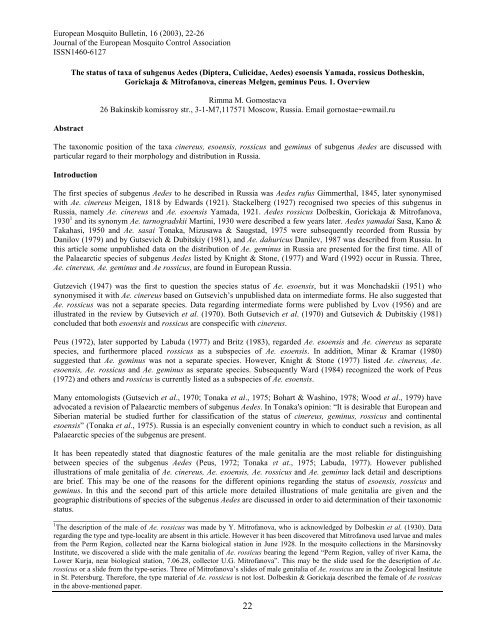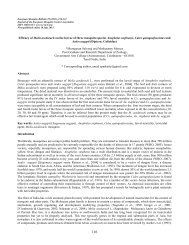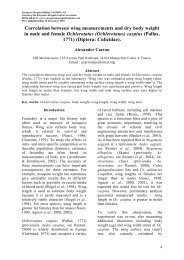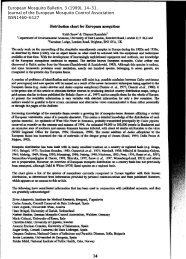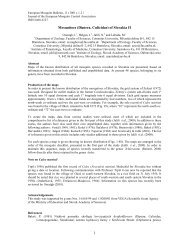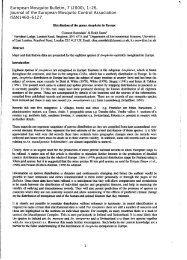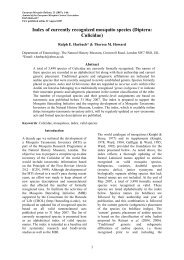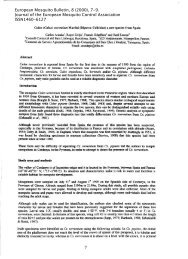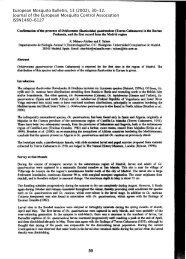Diptera, Culicidae, Aedes - European Mosquito Bulletin Journal of ...
Diptera, Culicidae, Aedes - European Mosquito Bulletin Journal of ...
Diptera, Culicidae, Aedes - European Mosquito Bulletin Journal of ...
Create successful ePaper yourself
Turn your PDF publications into a flip-book with our unique Google optimized e-Paper software.
<strong>European</strong> <strong>Mosquito</strong> <strong>Bulletin</strong>, 16 (2003), 22-26<strong>Journal</strong> <strong>of</strong> the <strong>European</strong> <strong>Mosquito</strong> Control AssociationISSN1460-6127AbstractThe status <strong>of</strong> taxa <strong>of</strong> suhgenus <strong>Aedes</strong> (<strong>Diptera</strong>, <strong>Culicidae</strong>, <strong>Aedes</strong>) esoensis Yamada, rossicus Dotheskin,Gorickaja & Mitr<strong>of</strong>anova, cinereas Melgen, geminus Peus. 1. OverviewRimma M. Gomostacva26 Bakinskib komissroy str., 3-1-M7,117571 Moscow, Russia. Email gornostae~ewmail.ruThe taxonomic position <strong>of</strong> the taxa cinereus, esoensis, rossicus and geminus <strong>of</strong> subgenus <strong>Aedes</strong> are discussed withparticular regard to their morphology and distribution in Russia.IntroductionThe first species <strong>of</strong> subgenus <strong>Aedes</strong> to he described in Russia was <strong>Aedes</strong> rufus Gimmerthal, 1845, later synonymisedwith Ae. cinereus Meigen, 1818 by Edwards (1921). Stackelberg (1927) recognised two species <strong>of</strong> this subgenus inRussia, namely Ae. cinereus and Ae. esoensis Yamada, 1921. <strong>Aedes</strong> rossicus Dolbeskin, Gorickaja & Mitr<strong>of</strong>anova,1930 1 and its synonym Ae. tarnogradskii Martini, 1930 were described a few years later. <strong>Aedes</strong> yamadai Sasa, Kano &Takahasi, 1950 and Ae. sasai Tonaka, Mizusawa & Saugstad, 1975 were subsequently recorded from Russia byDanilov (1979) and by Gutsevich & Dubitskiy (1981), and Ae. dahuricus Danilev, 1987 was described from Russia. Inthis article some unpublished data on the distribution <strong>of</strong> Ae. geminus in Russia are presented for the first time. All <strong>of</strong>the Palaearctic species <strong>of</strong> subgenus <strong>Aedes</strong> listed by Knight & Stone, (1977) and Ward (1992) occur in Russia. Three,Ae. cinereus, Ae. geminus and Ae rossicus, are found in <strong>European</strong> Russia.Gutzevich (1947) was the first to question the species status <strong>of</strong> Ae. esoensis, but it was Monchadskii (1951) whosynonymised it with Ae. cinereus based on Gutsevich’s unpublished data on intermediate forms. He also suggested thatAe. rossicus was not a separate species. Data regarding intermediate forms were published by Lvov (1956) and areillustrated in the review by Gutsevich et al. (1970). Both Gutsevich et al. (1970) and Gutsevich & Dubitskiy (1981)concluded that both esoensis and rossicus are conspecific with cinereus.Peus (1972), later supported by Labuda (1977) and Britz (1983), regarded Ae. esoensis and Ae. cinereus as separatespecies, and furthermore placed rossicus as a subspecies <strong>of</strong> Ae. esoensis. In addition, Minar & Kramar (1980)suggested that Ae. geminus was not a separate species. However, Knight & Stone (1977) listed Ae. cinereus, Ae.esoensis, Ae. rossicus and Ae. geminus as separate species. Subsequently Ward (1984) recognized the work <strong>of</strong> Peus(1972) and others and rossicus is currently listed as a subspecies <strong>of</strong> Ae. esoensis.Many entomologists (Gutsevich et al., 1970; Tonaka et al., 1975; Bohart & Washino, 1978; Wood et al., 1979) haveadvocated a revision <strong>of</strong> Palaearctic members <strong>of</strong> subgenus <strong>Aedes</strong>. In Tonaka's opinion: “It is desirable that <strong>European</strong> andSiberian material be studied further for classification <strong>of</strong> the status <strong>of</strong> cinereus, geminus, rossicus and continentalesoensis” (Tonaka et al., 1975). Russia is an especially convenient country in which to conduct such a revision, as allPalaearctic species <strong>of</strong> the subgenus are present.It has been repeatedly stated that diagnostic features <strong>of</strong> the male genitalia are the most reliable for distinguishingbetween species <strong>of</strong> the subgenus <strong>Aedes</strong> (Peus, 1972; Tonaka et at., 1975; Labuda, 1977). However publishedillustrations <strong>of</strong> male genitalia <strong>of</strong> Ae. cinereus, Ae. esoensis, Ae. rossicus and Ae. geminus lack detail and descriptionsare brief. This may be one <strong>of</strong> the reasons for the different opinions regarding the status <strong>of</strong> esoensis, rossicus andgeminus. In this and the second part <strong>of</strong> this article more detailed illustrations <strong>of</strong> male genitalia are given and thegeographic distributions <strong>of</strong> species <strong>of</strong> the subgenus <strong>Aedes</strong> are discussed in order to aid determination <strong>of</strong> their taxonomicstatus.________________________________________________________________________________________________1 The description <strong>of</strong> the male <strong>of</strong> Ae. rossicus was made by Y. Mitr<strong>of</strong>anova, who is acknowledged by Dolbeskin et al. (1930). Dataregarding the type and type-locality are absent in this article. However it has been discovered that Mitr<strong>of</strong>anova used larvae and malesfrom the Perm Region, collected near the Karna biological station in June 1928. In the mosquito collections in the MarsinovskyInstitute, we discovered a slide with the male genitalia <strong>of</strong> Ae. rossicus bearing the legend “Perm Region, valley <strong>of</strong> river Kama, theLower Kurja, near biological station, 7.06.28, collector U.G. Mitr<strong>of</strong>anova”. This may be the slide used for the description <strong>of</strong> Ae.rossicus or a slide from the type-series. Three <strong>of</strong> Mitr<strong>of</strong>anova’s slides <strong>of</strong> male genitalia <strong>of</strong> Ae. rossicus are in the Zoological Institutein St. Petersburg. Therefore, the type material <strong>of</strong> Ae. rossicus is not lost. Dolbeskin & Gorickaja described the female <strong>of</strong> Ae rossicusin the above-mentioned paper.22
<strong>European</strong> <strong>Mosquito</strong> <strong>Bulletin</strong>, 16 (2003), 22-26<strong>Journal</strong> <strong>of</strong> the <strong>European</strong> <strong>Mosquito</strong> Control AssociationISSN1460-6127Methods<strong>Mosquito</strong>es were collected by Y.N. Danilov and the author from Krasnoyarsk Territory, Khakassia, Tuva, IrkutskRegion, Buriatia, Chita Region and Amur Region in the south <strong>of</strong> Sibeda. In addition, specimens <strong>of</strong> Ae. cinereus, Ae.rossicus and Ae. geminus were collected from the Moscow Region, Tatar Republic and Perm Regions <strong>of</strong> <strong>European</strong>Russia and from Obol in Byelarus. These, together with specimens <strong>of</strong> Ae. esoensis from Sakhalin Island, were studiedfrom the collection in the Marsinovsky Institute. In total 148 slides <strong>of</strong> male genitalia <strong>of</strong> the subgenus <strong>Aedes</strong> wereexamined.Diagnostic features for distinguishing between Ae. rossicus, Ae. esoensis, Ae. cinereus and Ae. geminus (figuresillustrating these features are in the second part <strong>of</strong> this article). See also Tables 1 and 2.Key to male genitalia1. Longer(lateral)arm <strong>of</strong> gonostylus apically bifurcate........................................................2- Longer (lateral) arm <strong>of</strong> gonostylus not apically bifurcate.................................................32. Lateral branch <strong>of</strong> apical bifurcation <strong>of</strong> gonostylus narrower and shorter than medialbranch; basal mesal lobe <strong>of</strong> the gonocoxite cone-shaped dorsomedially and bearingdense, evenly spaced setae..............................................………………….......Ae. cinereus- Lateral branch <strong>of</strong> bifurcation <strong>of</strong> gonostylus longer than medial branch; basal mesal lobe<strong>of</strong> gonocoxite not cone-shaped and bearing fewer set…...................................Ae. geminus3. Claspers 2 with two branches; medial am <strong>of</strong> gonostylus more than half length <strong>of</strong> lateralarm; apex <strong>of</strong> medial arm with even outline ......................................................Ae. rossicus- Claspettes with one branch (rudiment <strong>of</strong> the second branch seldom present); medial arm<strong>of</strong> gonostylus less than half length <strong>of</strong> lateral arm; apex <strong>of</strong> medial arm with wavy outline............................................................................................................................Ae. esoensisKey to females1. Abdominal terga unicolorous, without bands..………………………………................2- Abdominal tergites with light-coloured bands at base………………………Ae. esoensis2. Eye margin with white scales; proboscis and palpus with numerous white scales............................................................................................................................Ae. rossicus- Eye margin with grey scales, proboscis and palpus without white scales………………33. Pronotal integument rust or rusty-brown ......................................................Ae. cinereus- Pronotal integument brown, sometimes with black patches…………………Ae. geminus________________________________________________________________________2. The claspettes in the subgenus <strong>Aedes</strong> are so highly modified that Dyar (1918) and Gutsevich et al., (1970) stated that claspettes areabsent; they regarding the structures present as integral with the basal mesal lobe <strong>of</strong> the gonocoxite. Freeborn (1924) also discussedthe relationship between claspettes and the basal mesal lobe. Natvig (1948) coined the tem “claspettoid” for the processes presentedby the subgenera <strong>Aedes</strong> and Aedimorphus, but Harbach and Knight (1980) synonymised this term with claspette. In this paper wefollow Harbach & Knight in regarding these modified structures as claspettes.23
<strong>European</strong> <strong>Mosquito</strong> <strong>Bulletin</strong>, 16 (2003), 22-26<strong>Journal</strong> <strong>of</strong> the <strong>European</strong> <strong>Mosquito</strong> Control AssociationISSN1460-6127Table 1. Mean lengths (mm) <strong>of</strong> the gonocoxite, medial (M) and lateral (L) arms <strong>of</strong> the gonostylus <strong>of</strong> Ae. rossicus,Ae. esoensis, Ae. cinereus and Ae. geminus.Gonocoxite M L M/Lrossicus 0.55(0.54-0.58) 0.13(0.12-0.14) 0.21(0.20-0.22) 0.64(0.60-0.68)n=16 n=20 n=20 n=20esoensis 0.45(0.41-0.49) 0.09(0.08-0.10) 0.19(0.18-0.20) 0.46 (0.42-0.47)n=9 n=18 n=18 n=18cinereus 0.46(0.43-0.49) 0.11(0.10-0.11) 0.19(0.18-0.20) 0.58 (0.56-0.61)n=14 n=10 n=10 n=10geminus 0.49(0.45-0.50) 0.11(0.10-0.12) 0.20(0.19-0.21) 0.56 (0.50-0.60)n=13 n=17 n=17 n=17Table 2. Mean number <strong>of</strong> setae on medial and lateral branches <strong>of</strong> the claspette <strong>of</strong> Ae. rossicus, Ae. esoensis, Ae.cinereus and Ae. geminus.Medial branchLateral branchrossicus 4.2 (3-5) n=36 2.5 (1-5) n=36esoensis 3.2 (2-4) n=14 absentcinereus 3.1 (3-4) n=14 3.3 (2-5) n=14geminus 2.9 (2-4) n=61 3.2 (1-7) n=62Individual variabilityAll <strong>of</strong> the described features <strong>of</strong> Ae. rossicus, Ae. cinereus and Ae. geminus are stable for each species throughout theirdistribution in Russia. The greatest variation is in the claspettes <strong>of</strong> species <strong>of</strong> subgenus <strong>Aedes</strong>, especially Ae. rossicus.Nevertheless the structure <strong>of</strong> the claspette is a reliable feature for diagnosing the species. The descriptions and theillustrations <strong>of</strong> Ae. rossicus, Ae. cinereus, Ae. geminus from Europe (Natvig, 1948; Peus, 1970, 1972; Labuda, 1977)testify to the stability <strong>of</strong> the diagnostic features.Our data on individual variation <strong>of</strong> Ae. esoensis are available only from Sakhalin Island. However the descriptions <strong>of</strong>Ae. esoensis from Maritime Territory (Stackelberg, 1927; Gutsevich et al., 1970) and from Japan (Tonaka et al., 1975,1979) show stability <strong>of</strong> described morphological features <strong>of</strong> this species.Distributions <strong>of</strong> Ae. cinereus, Ae. geminus, Ae. rossicus and Ae. esoensis in Russia and the Palaearctic<strong>Aedes</strong> cinereusMore detailed information is required regarding the distribution <strong>of</strong> Ae. cinereus because Ae. yamadai, Ae. sasai, Ae.dahuricus and Ae. geminus were earlier synonymised with Ae. cinereus. Furthermore the illustrations <strong>of</strong> the dististyle(= gonostylus) and claspette variation in forms regarded by Lvov (1956) as intermediate between Ae. cinereus and Ae.esoensis agree closely with features <strong>of</strong> Ae. sasai (Tonaka et al., 1979). However there is no doubt that in Russia Ae.cinereus is distributed from the <strong>European</strong> borders to the far east (Gutsevich et al., 1970).24
<strong>European</strong> <strong>Mosquito</strong> <strong>Bulletin</strong>, 16 (2003), 22-26<strong>Journal</strong> <strong>of</strong> the <strong>European</strong> <strong>Mosquito</strong> Control AssociationISSN1460-6127<strong>Aedes</strong> rossicusThe distribution <strong>of</strong> Ae. rossicus ranges from western Europe (Snow & Ramsdale, 1999) through <strong>European</strong> Russia toYakut in Asiatic Russia. <strong>Aedes</strong> rossicus was recorded in <strong>European</strong> Russia in the Yoronezh Region, Nizhni NovgorodRegion, Ulyanovsk Region, Chuvashia, Tatarstan, Udmurt Republic, Mariy-El, Rostov-on- Don Region, North-Ossetia(as Ae. tarnogradskii), Orenburg and Perm Regions. In Asiatic Russia Ae. rossicus was recorded in the Omsk Region,Tyumen Region (near Nefteyugansk, Novosibirsk, Tuva, Buriatia, southern Yakutia. In our collections we additionallyhave Ae. rossicus from the neighbourhoods <strong>of</strong> Krasnoyarsk (Krasnoyarsk Territory), from Abakan and Maina(Khakassia), from Taximo (Buriatia), from the south <strong>of</strong> Chita Region. It is known that Ae. rossicus also has a widedistribution in the Ukraine. It must be noted that the <strong>Aedes</strong> rossicus <strong>of</strong> Hara (1958) from Japan is Ae. dahuricus(Danilov, 1987).<strong>Aedes</strong> geminus<strong>Aedes</strong> geminus is a widely distributed species in Europe (Snow & Ramsdale, 1999). <strong>Aedes</strong> geminus is present in thecollections <strong>of</strong> V.N. Danilov and myself from Abakan and Maina (Khakassia), Tuva, Ust Kut (Irkutsk Region),Nothbaikalsk and Taximo (Budatia), Chara (Chita Region), Zeyia (Amur Region) and Komsomolsk Region(Khabarovsk Territory). Males <strong>of</strong> Ae. geminus from Byelorussia and from the Moscow Region were found in thecollections <strong>of</strong> the Marsinovsky Institute. Therefore, the distribution <strong>of</strong> Ae. geminus covers most <strong>of</strong> the Palaearctic.<strong>Aedes</strong> geminus, Ae. cinereus and Ae. rossicus are therefore distributed widely in Europe and Asia.<strong>Aedes</strong> esoensisIn Russia, Ae. esoensis is found in Amur Region, Khabarovsk Territory, Primorski Region (=Maritime Territory), ChitaRegion and on Kunashir and Shikotan Islands. In the Chita Region both Ae. rossicus and Ae. esoensis have beenrecorded in the valley <strong>of</strong> the river Onon. However Ae. rossicus is not found in close association with Ae. esoensis. Alsoit is possible that there may be some confusion between Ae. dahuricus and Ae. esoensis. At present there is noconclusive information regarding the sympatry or allopatry <strong>of</strong> Ae. rossicus and Ae. esoensis in Russia.DiscussionThe differences between the male genitalia <strong>of</strong> those species <strong>of</strong> subgenus <strong>Aedes</strong> that have been studied are significantand represent isolating mechanisms. All <strong>of</strong> the considered morphological features are constant and stable for eachspecies throughout their geographical ranges. The sympatric distributions <strong>of</strong> Ae. cinereus, Ae. geminus and Ae. rossicusin Europe and Asia, sympatric distributions <strong>of</strong> Ae. cinereus and Ae. esoensis in Asia, constancy <strong>of</strong> describedmorphological adult features <strong>of</strong> each species throughout their distribution and absence <strong>of</strong> intermediate forms may beregarded as indisputable evidence for the non-conspecificity <strong>of</strong> Ae. rossicus, Ae. esoensis, Ae. geminus and Ae.cinereus.Although the evidence is not conclusive, it would appear that Ae. rossicus and Ae. esoensis are allopatric in Russia andintermediate forms between these taxa have not been observed 3 . According to Mayr (1971) in such a case the allopatrictaxa should he regarded as separate species. We regard the opinion <strong>of</strong> Peus (1972) that Ae. rossicus and Ae. esoensisare conspecific as erroneous.The taxa esoensis, rossicus, cinereus and geminus should therefore be regarded as separate species <strong>of</strong> subgenus <strong>Aedes</strong>:Ae. esoensis Yamada, 1921, Ae. rossicus Dolbeskin, Gorickaja & Mitr<strong>of</strong>anova, 1930, Ae. cinereus Meigen, 1818, Ae.geminus Peus, 1970. Additionally, all species <strong>of</strong> subgenus <strong>Aedes</strong> in Russia should be regarded as separate species(Danilov, 1987; Mamedniyazov, 1992; Gornostaeva, 2000).AcknowledgementsWe wish to acknowledge the use <strong>of</strong> Danilov’s expeditionary journals and his slides <strong>of</strong> male genitalia made during theexpeditions. I wish to thank Ralph Harbach, Keith Snow and Clement Ramsdale for their helpful comments.________________________________________________________________________________________________3.Illustrations <strong>of</strong> Lvov (1956) do not show intermediate forms but the species Ae. sasai and Ae. yamadai25
<strong>European</strong> <strong>Mosquito</strong> <strong>Bulletin</strong>, 16 (2003), 22-26<strong>Journal</strong> <strong>of</strong> the <strong>European</strong> <strong>Mosquito</strong> Control AssociationISSN1460-6127ReferencesBohart, R.M. & Washino, R.K. (1978) <strong>Mosquito</strong>es <strong>of</strong> California. Third edition. Division <strong>of</strong> agricultural sciences University <strong>of</strong>California. Berkeley, 50.Britz, L. (1983) Uber einheimische Stechmucken des Subgenus <strong>Aedes</strong> (<strong>Diptera</strong>, <strong>Culicidae</strong>). Angewandte Parasitologie 24, 152-156.Danilov, V.N. (1979) <strong>Aedes</strong> (<strong>Aedes</strong>) jamadai Sasa, Kano et Takahasi, a species new for the fauna <strong>of</strong> USSR (<strong>Diptera</strong>, <strong>Culicidae</strong>). In:Taksonomija i Ekologia Chlenistonogikh Sibiri. Novosibirsk, 149-153 (In Russian).Danilov, V.N. (1987) <strong>Mosquito</strong>es <strong>of</strong> the subgenus <strong>Aedes</strong> (<strong>Diptera</strong>, <strong>Culicidae</strong>) <strong>of</strong> the USSR fauna. II. <strong>Aedes</strong> dahuricus sp.n. VestnicZoologii 4, 35-41 (In Russian).Dolbeskin, B.I., Gorickaja, V.V. & Mitr<strong>of</strong>anova, J.G. (1930). The description <strong>of</strong> a new species <strong>of</strong> genus <strong>Aedes</strong> from East Europe.Parasitologicheskiy sbornic 1, 253-260 (In Russian).Dyar, H.G. (1918) The male genitalia <strong>of</strong> <strong>Aedes</strong> as indicative <strong>of</strong> natural affinities. Insecutor Insitiae Menstruus, 6, 71-86.Edwards, F.W. (1921) A revision <strong>of</strong> the mosquitoes <strong>of</strong> the Palaearctic region. <strong>Bulletin</strong> <strong>of</strong> Entomological Research 12, 236-351.Freeborn S.B. (1924) The terminal abdominal structures <strong>of</strong> male mosquitoes. American <strong>Journal</strong> <strong>of</strong> Hygiene 4, 188-212.Gornostaeva, R.M. (2000) A revised checklist <strong>of</strong> the mosquitoes (<strong>Diptera</strong>, <strong>Culicidae</strong>) <strong>of</strong> <strong>European</strong> Russia. <strong>European</strong> <strong>Mosquito</strong><strong>Bulletin</strong> 6, 15-26.Gutsevich, A.V. (1947). <strong>Mosquito</strong>es, <strong>Culicidae</strong>. In: Parasitology <strong>of</strong> Far East (editor Pavlovskiy). Leningrad, 20- 38 (In Russian).Gutsevich, A.V., Monchadskii, A.S. & Stackelberg, A.A. (1970) <strong>Mosquito</strong>es. Family <strong>Culicidae</strong> (In Russian). Fauna <strong>of</strong> the USSR 3(4). 384 pp. In English(1974) Keter Publishing House. Jerusalem.Gutsevich, A.V. & Dubitskiy, A.M. (1981) New species <strong>of</strong> mosquitoes in the fauna <strong>of</strong> the USSR (In Russian). Parasitologicheskiysbornic 30, 97-165. <strong>Mosquito</strong> Systematics 19, 1-92.Hara, J. (1958) On the newly recorded mosquito, <strong>Aedes</strong> (<strong>Aedes</strong>) rossicus Dolbeskin, Gortheirkaja and Mitr<strong>of</strong>anova, 1930 with thekeys to the species belonging subgenus <strong>Aedes</strong> known from Japan (<strong>Diptera</strong>: <strong>Culicidae</strong>). Taxonomical and ecologicalstudies on mosquitoes <strong>of</strong> Japan (Part 10). Japanese <strong>Journal</strong> <strong>of</strong> sanitary Zoology 9, 23-27.Harbach, R.E. & Knight, K.L. (1980) Taxonomists' Glossary <strong>of</strong> <strong>Mosquito</strong> Anatomy. Plexus Publishing, New Jersey. 415 ppKnight, K.L. & Stone, A. (1977) A catalog <strong>of</strong> the mosquitoes <strong>of</strong> the world. Thomas Say Foundation 6, 70-72.Labuda, M. (1977) Species <strong>of</strong> subgenus <strong>Aedes</strong> s. str. (<strong>Diptera</strong>, <strong>Culicidae</strong>) in Czechoslovakia. Acta Universitatis Carolinae, BiologicaPraha 5-6 (Dipterologica Bohemoslovaca 2), 329-335.Lvov, D.K. (1956) On the specific independence <strong>of</strong> the mosquito Ae. esoensis Jam. vector <strong>of</strong> Japanese Encephalitis. Revued'entomologie de I'URSS 35 (4), 929-934 (In Russian).Mamedniyasov, O. (1992) Data on fauna <strong>of</strong> mosquitoes <strong>of</strong> the USSR (<strong>Diptera</strong>, <strong>Culicidae</strong>). Parasitologicheskiy sbornic 37, 41-56 (InRussian).Minar, J. & Kramer, J. (1980) Faunistics and zoogeography <strong>of</strong> mosquitoes (<strong>Diptera</strong>, <strong>Culicidae</strong>) <strong>of</strong> Central Europe in view <strong>of</strong> forestcommunities. Acta Musei Reginaehradecensis S. A. Supplementum, 68-70.Mayr, E. (1971) Principles <strong>of</strong> Systematic Zoology. Moscow. 454 pp.Monchadskii, A. S. (1951) The larvae <strong>of</strong> bloodsucking mosquitoes <strong>of</strong> the USSR and adjoining countries (Subfam. Culicinae). (InRussian). Tableaux Analytiques de la Faune de 1'USSR 37, 1-290.Natvig, L.P. (1948) Contributions to the knowledge <strong>of</strong> the Danish and Fennoscandian mosquitoes (Culicini). Norske EntomologiskTidsskrift Supplement 1, 400-412.Pens, F. (1972) Uber das subgenus <strong>Aedes</strong> sensu stricto in Deutschland (<strong>Diptera</strong> <strong>Culicidae</strong>). Zetheirchpift fur AngewandteEntomologie 72, 172-194.Snow, K. & Ramsdale, C. (1999) Distribution chart for <strong>European</strong> mosquitoes. <strong>European</strong> <strong>Mosquito</strong> <strong>Bulletin</strong> 3, 14-31.Stackelberg, A. (1927). Les Culicides de I'URSS et des pays limitrophes. Tableaux analytiques de la faune de I'URSS publies par lemusee zoologique de l’Academie des sciences 1, 1-170 (In Russian).Tonaka, K., Mizusava, K. & Saugstad, E.S. (1975). A new species <strong>of</strong> the genus <strong>Aedes</strong> (<strong>Aedes</strong>) from Japan, with synonymical noteson Japanese species <strong>of</strong> the subgenus <strong>Aedes</strong> (<strong>Diptera</strong>, <strong>Culicidae</strong>). <strong>Mosquito</strong> Systematics 7(1), 41-58 and 7(2), 174-177.Tonaka, K., Mizusava, K. & Saugstad, E.S.(1979) A revision <strong>of</strong> the adult and larval mosquitoes <strong>of</strong> Japan (including the RyukyuArchipelago and the Ogasawara Islands) and Korea (<strong>Diptera</strong>, <strong>Culicidae</strong>). Contributions <strong>of</strong> the AmericanEntomological Institute 16, 1-987.Ward, R.A. (1984) Second supplement to a Catalog <strong>of</strong> the mosquitoes <strong>of</strong> the World. <strong>Mosquito</strong> Systematics 16, 233.Ward, R.A. (1992) Third supplement to A Catalog <strong>of</strong> the mosquitoes <strong>of</strong> the World (<strong>Diptera</strong>, <strong>Culicidae</strong>). <strong>Mosquito</strong> Systematics 24,184.Wood, D.M., Dang, P.T. & Ellis, R.A. (1979) The <strong>Mosquito</strong>es <strong>of</strong> Canada. <strong>Diptera</strong>: <strong>Culicidae</strong>. The Insects and Arachnids <strong>of</strong> Canada.Part 6. 158 pp.26


